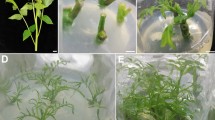Summary
In our wide-ranging research on in vitro propagation of some monocotyledonous plants, two Commelinaceae species were studied: Tradescantia fluminensis var. foliis variegatis and Tradescantia pallida. Initial cultures were established successfully using nodal and apical meristems that produced single shoots, many roots, and no callus, by utilizing growth regulator-free MS medium. Addition of growth regulators did not increase the activity of explants that produced single or multiple shoots, atypical roots, and no callus. Consecutive cultures were possible using the apical and nodal meristems of the previous generation. The behavior of the different generations in culture did not change and was similar to the initial cultures. Their growth capacity was maintained over many months, also on a growth regulator-free medium. In both species, the chromosome number in the root tips of the mother plant and all morphologically stable in vitro plantlets confirmed a constant ploidy level, in T. fluminensis 2n=72, and in T. pallida 2n=24.
Similar content being viewed by others
References
Battaglia, E. A new 5 minute fixation in chromosome analysis. Caryologia 19:368–370; 1957.
Bhojwani, S.S.; Dhawan, V.; Arora, R. Plant tissue culture, a classified bibliography. Amsterdam/Oxford: Elsevier; 1990.
Bhojwani, S.S.; Dhawan, V.; Cocking, C.E. Plant tissue culture, a classified bibliography. Amsterdam/Oxford: Elsevier; 1986.
Choi, Y.E.; Yang, D.C.; Yoon, E.S.; Choi, K.T. Plant regeneration via adventitious bud formation from cotyledon explants of Panax ginseng C.A. Meyer. Plant Cell Rep. 17:731–736; 1998.
Darlington, C.D.; Wylie, A.P. Chromosome atlas of flowering plants. London: Allen & Unwin; 1955:338–339.
Escandón, A.; Martinez, A.; Caso, O.H.; Pomar, M.C. Regeneration of aneuploid plants from tetraploid (2n=24) Tradescantia crassifolia Cav. through callus culture. Plant Physiol. 119:467–472; 1985.
Levan, A.; Fredga, K.; Sandberg, A. Nomenclature for centromeric position on chromosomes. Hereditas 52:201–220; 1964.
Masuda, K.; Koda, Y.; Okazowa, Y. Callus formation and embryogenesis of endosperm tissues of parsley seed cultured on hormone-free medium. Physiol. Plant. 41:135–138; 1977.
Murashige, T.; Skoog, F. A revised medium for rapid growth and bioassays with tobacco tissue cultures. Physiol. Plant. 15:473–497; 1962.
Pérez-Francés, J.F.; Valdés, F.; Martin, R. Callus induction and culture from explants of Erysimum scoparium in a growth regulator-free medium. Plant Cell Tiss. Organ Cult. 43:223–228; 1995.
Scaramuzzi, F.; Giodice, L.; Berlingerio, M.; Apollonio, G. Observations sur la propagation in vitro de deux espèces de la famille des Marantaceae: Ctenanthe lubbersiana Eichl. et Maranta leuconeura Morren var. tricolor. C. R. Soc. Biol. 186:458–469; 1992.
Stebbins, G.L. Chromosomal evolution in higher plants. London: Edward Arnold; 1971.
Author information
Authors and Affiliations
Corresponding author
Rights and permissions
About this article
Cite this article
Scaramuzzi, F., Apollonio, G. & D'Emerico, S. In vitro propagation of two species of commelinaceae from bud cultures and repeated subcultures on a growth regulator-free medium. In Vitro Cell.Dev.Biol.-Plant 36, 379–382 (2000). https://doi.org/10.1007/s11627-000-0068-5
Received:
Accepted:
Issue Date:
DOI: https://doi.org/10.1007/s11627-000-0068-5




